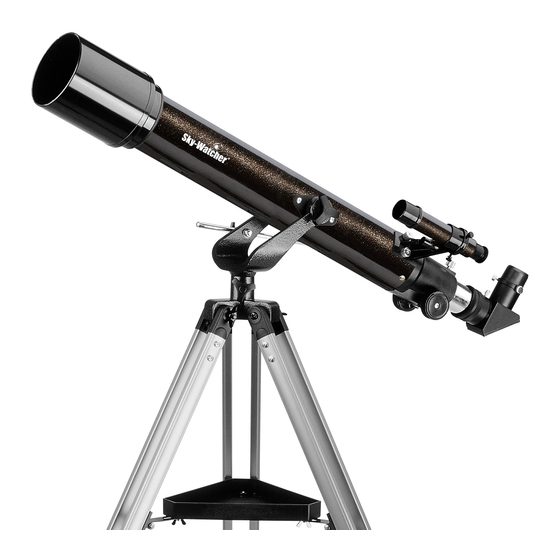
Advertisement
Quick Links
INSTRUCTION MANUAL
Optical Tube: 70mm/700mm
Finderscope
Finderscope Bracket
Finderscope Alignment
Screws
Focus Locking Screw
Eyepiece
Diagonal
Focus Tube
Focus Knob
Altitude Fine-adjustment
Control
Azimuth Lock Knob
Accessory Tray
Tripod Leg
Height Adjustment
Clamp
FOR 707AZ2
Alt-Azimuth Mount: AZ2
Telescope Main Tube
Objective Lens
Dew Cap / Sun Shade
Dust Cap / Mask
(Remove before Viewing)
Yoke Locking Knob
Altitude Lock Knob
Yoke Mount
Advertisement

Summary of Contents for SKY-WATCHER 707AZ2
- Page 1 INSTRUCTION MANUAL FOR 707AZ2 Alt-Azimuth Mount: AZ2 Optical Tube: 70mm/700mm Finderscope Telescope Main Tube Objective Lens Finderscope Bracket Dew Cap / Sun Shade Finderscope Alignment Screws Dust Cap / Mask Focus Locking Screw (Remove before Viewing) Eyepiece Yoke Locking Knob...
- Page 2 TABLE OF CONTENTS Assembling Your Telescope Tripod Set up Telescope Assembly Finderscope Assembly Eyepiece Assembly Alligning the Finderscope Operating Your Telescope Operating the AZ2 Mount Using the Barlow Lens Focusing Pointing Your Telescope Calculating the Magnification (power) Calculating the Field of View Calculating the Exit Pupil Observing the Sky Sky Conditions...
- Page 3 TRIPOD SET UP Fig.1 ASSEMBLING TRIPOD LEGS (Fig.1) 1) Gently push middle section of each tripod leg at the top so that the pointed foot protrudes below the tripod clamp. 2) Insert tripod lock screws into the thread holes on the side of the tripod and clamp without over-tightening.
- Page 4 FINDERSCOPE ASSEMBLY Fig. 8 ATTACHING THE FINDERSCOPE (Fig. 8, 9) 1) Locate finderscope optical assembly. 2) Remove the two knurled thumbscrews near the end of the telescope main tube. 3) Position the finderscope bracket over Fig. 9 the screws in the telescope main body. 4) Secure the finderscope bracket with the two knurled thumbscrews.
- Page 5 OPERATING YOUR TELESCOPE Fig.a This telescope has an altitude(up-down)- azimuth(left-right) mount to control telescope movements. Loosen the azimuth lock knob Altitude adjustment to make left-right direction movements then tighten to lock. Loosen the altitude lock knob to make course up-down changes. Altitude fine adjustments can be made by rotating the knurled wheel on the altitude fine adjustment rod after tightening the altitude...
- Page 6 Pointing an altitude-azimuth (alt-az) mounted telescope is relatively easy. With the mount level, you can swivel the telescope around on a plane parallel to your horizon and then tilt it up and down from there (Fig.c). You can think of it as turning your telescope in azimuth until it is facing the horizon below a celestial object and then tilting it up to the object's altitude.
- Page 7 The magnification produced by a telescope is determined by the focal length of the eyepiece that is used with it. To determine a magnification for your telescope, divide its focal length by the focal length of the eyepieces you are going to use. For example, a 10mm focal length eyepiece will give 80X magnification with an 800mm focal length telescope.
- Page 8 OBSERVING THE SKY Sky conditions are usually defined by two atmospheric characteristics, seeing, or the steadiness of the air, and transparency, light scattering due to the amount of water vapour and particulate material in the air. When you observe the Moon and the planets, and they appear as though water is running over them, you probably have bad "seeing"...
- Page 9 SUGGESTED READING Beginner's Guide to Amateur Astronomy: Astrophotography for the Amateur: by Michael Covington (Cambridge University Press, Cambridge, An Owner's Manual for the Night Sky by David J. UK, 2nd edition,1999). Eicher and, Michael Emmerich (Kalmbach Publishing Co., Books Division, Waukesha, WI, 1993). Splendors of the Universe: A Practical Guide to Photographing the Night Sky by Terence Dickinson NightWatch: A Practical Guide to Viewing the...















Need help?
Do you have a question about the 707AZ2 and is the answer not in the manual?
Questions and answers